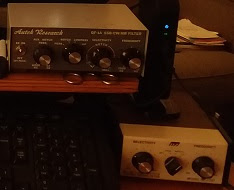the most frustrating RTTY events I've run in recent years. Success in running events remotely
relies on having access to a clean "internet pipeline" between the Host and the Remote locations.
This weekend for various reasons out of my control, while the connection SEEMED clean, internet dropouts (every minute or so) would result in the VNC Viewer software locking up. If I seemed to "disappear" or be slow to respond, that is because I was having to start a new instance of the VNC software, not because I was too drunk or stupid; I don't drink during radiosport operations from Alameda.
My BIGGEST BEEF for the contest weekend were the BARRAGE of RTTY stations calling
CQ Test atop the 14.100 NCDXF Beacon Frequency. You can't be a 20-meter RTTY operator
and NoT know about the beacon network; or at least, the beacon on 14.100. At least NoW you know. I don't transmit closer than 1-kc on either side of 14.100. What GooD are propagation beacons if I can't hear them due to RTTY QRM? Am I missing something here?
One of the MAIN reasons I ran this weekend was to test-drive another
dual-audio filter combination.
The last several years, I have used the Alameda QTH to test-run different audio filter combinations, discovering the best filter configuration for my operations from W7AYT's Concord QTH.
Finalizing that, next up was to discover the best configuration using the filters left over. The best combination is an Autek QF-1A (for left ear audio) and
an MFJ-751 (for right ear audio).
Ironically, while this step was a success, because of the internet dropouts, much of Sunday
was run with the receive audio turned off. Technically, audio is not necessary to run a frequency.
Paying attention to the "waterfall" and decoder displays is enough to run stations most of the time. During S&P running, while audio is a nice confirmation of being on frequency, in most cases, it was hardly necessary.
This contest was amazingly devoid of intentional QRM; even on 40-meters where I am notoriously plagued by idiot QRM'ers. The only difficulty came when stations would exactly zero-beat my run frequency (so I know it is no accident) and call "CQ Test". Function key F-11 is programmed
to send: WB6XYZ QRL QSY PSE". One or two presses of F-11 and "message received".
Frequencies like 14089.89 are purposely chosen to create a pleasing aesthetic effect when operators properly tune in my "CQ W.W. Test" calls. Unfortunately, for some unknown reason, some stations like to work me (get the QSO points first of course) and then immediately attempt a CQ call on the
run frequency - HuH?
Analyzing the log submissions to the 3830Scores website, it would seem that running as NX6T,
a 4th place was secured for W6 and 9th place for Zone 3 in the Single-OP assisted, high power category. While I only ran the Expert-2k amplifier at ~700 watts, virtually every station I called came right back, often over signals I considered to be twice as loud as NX6T.
For me, the BiG surprise came on Saturday and again on Sunday when a seemingly DEAD
15-meters delivered 2-dozen SA stations responding to my CQ calls on 21093.93, both during
the mid-afternoon.
I ran the Stepp-IR yagi in BI-directional mode hoping to work BoTH JA and SA stations intermixed. While that worked well on 20-meters, there were no JA's heard on 15-meters - Bummer Dewd!
Did YOU work the CQ W.W. RTTY contest?
Is NX6T in YOUR LoG?




No comments:
Post a Comment